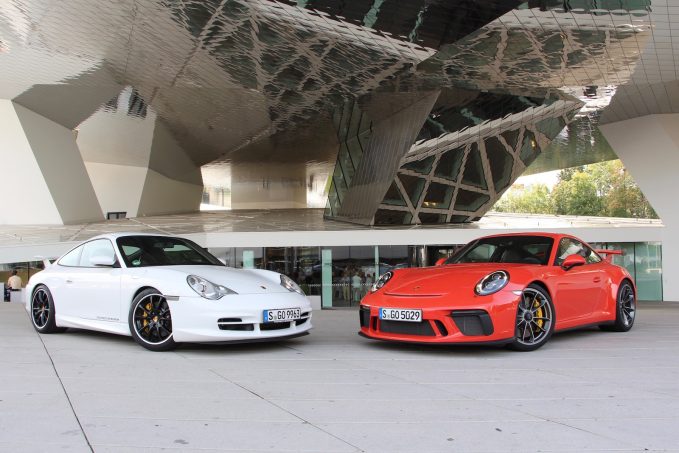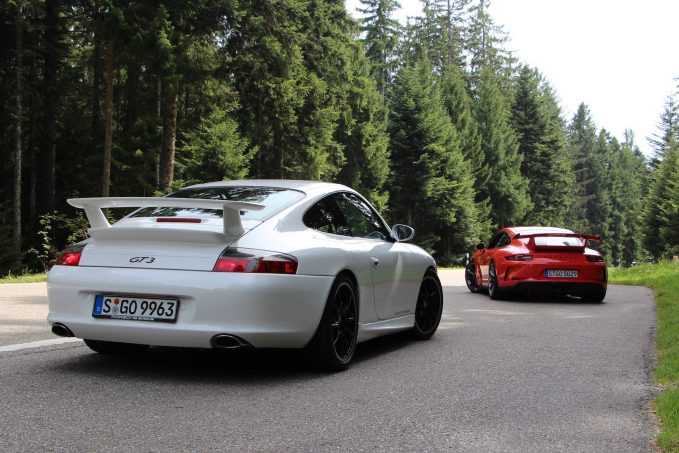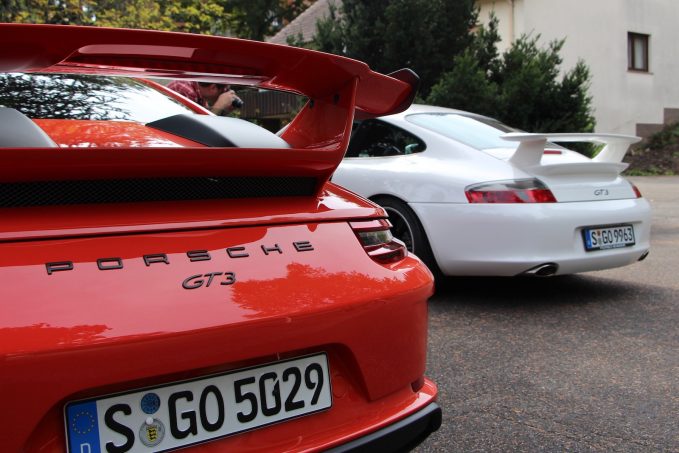Of course any new Porsche 911 GT3 is going to be spectacular, but is it as good as earlier generations? We drive the new 2018 and 2004 back to back to see how this racecar for the road has evolved.
The Original
The smell of gasoline.
That’s the first thing that will come to mind whenever I think of my first moments in the 996 Porsche 911 GT3.
After spending half an hour in the brand new 2018 911 GT3 (991, or 991.2 if you really want to get nerdy about it), the smell of gasoline wafting from the 996 was almost overpowering, like a toxic elixir, repellant yet irresistible, a smell I’ve always loved, but so strong that I expected to see a stream of gasoline pooling under the rear bumper.
Nope? Okay, we’re good to go then.
The engine pretty much would have had to fall out on the side of the road for me to not drive it. Standing at the side of some German sideroad somewhere outside of Stuttgart, my turn had finally come to swap out of the 991 and into the 996.
Sure, the 996 is the redheaded stepchild of the 911 lineage, its droopy headlights, IMS issues and early water-cooled engine just too much change all at once for perhaps the most traditionalist fan base of any brand or model. But really it’s mostly the headlights. What were they thinking?
ALSO SEE: New Porsche 911 GT3 is Much Faster Than its Predecessor
Still, this GT3 is everything that defines the 911 legend: a flat-six-cylinder engine hanging out over the rear axle driving the rear wheels, connected to the driver via three pedals and a stick that you shift with only the skills your hand and feet can muster. When new, it was the cream of the sports car crop, a sports car with added focus as a track special without being a compromised racecar. This being the 996.2 GT3 with subtle updates to those freakish headlights, its 381 hp was an impressive output for 3.6 liters, but at 284 lb-ft, its torque sounds almost feeble by today’s standards.
Now we see that kind of power in family sedans or luxury SUVs – and that’s the middle of the range.
But this was in an era when you had to work for your kicks, with peak torque only arriving at 5,000 rpm, then horsepower reaching its max only at 7,400 rpm, and the engine keeps spinning right up to a gloriously screeching 8,200. To reach that ethereal rev range, Porsche lightened and fortified reciprocating mass in the engine, and then matched it with bigger brakes, a stiffer, dropped suspension, lightweight wheels and, of course, a big-ass spoiler that provided better downforce at speed.
If there was a weak link in the 996 GT3’s driving experience, it was its low-speed power, feeling like it takes forever to get to 4,000 rpm in first gear, which is when that flat-six finally starts to wail and pull the car into its comfort zone. And by comfort I mean absolutely annihilating corners and screaming away from them if you can keep it in the power band. Thankfully, the pedal placement is so fantastic that it makes it seem downright easy to heel-toe, allowing quick downshifts without any lag and uninterrupted power through corners. It’s almost as easy as the PDK is fast.
From the transmission to the chassis to the engine, the car is pure visceral entertainment. Throttle response is instantaneous in the power band, and the firm, (very) narrow seats lock you in place to control the car through the old-school hydraulic steering. While the steering ratio doesn’t seem quick at first after stepping out of the 991, there is so much more information dancing at your fingertips, with a bit of give and pull as the tires shift and bite, accompanied by subtle tugs and tension felt in the chassis through the body-hugging seats.
In the 991, it’s not that there is no feel, it’s just that there is no ‘noise’, not as in that raucous exhaust noise which is alive and well, but rather the ‘unnecessary’ body movement and inputs that hamper ‘perfect’ control. Why the air quotes? Well, while Porsche has decided to refine that superfluous input out of their most engaging car, it is that very thing that has drawn so many to the Porsche brand through the words of our writing heroes that have put us in the driver’s seat along with them before we ever took the wheel. Feel. Feedback. It’s the quality that turned the 911 and Miata and 3 Series into icons, pairing with their precision and balance to earn each of them the beloved Driver’s Car designation over the past three decades. Well, Porsche had to exorcise some demons on the balance part of the 911 in its early years, but by the 996 generation it was no longer the hairy, oversteering widowmaker of its first generations, and this was the driver’s car of the 911 range.
The Heir Apparent
It still is.
And the new one is better in just about every way.
It’s faster, handles better, sounds better and feels more dialed in when ripping through corners at speeds that should probably only be tested on a racetrack.
The 911 has evolved over the past decade and a half, and the GT3 is now in its third iteration, though this 991.2 edition offers a boon to those traditionalists, skipping the turbocharged powerplan
ts now standard across the entire 911 range, and even reviving the manual transmission as an option after seeing the success of the limited edition 911R. While we didn’t get to sample the manual transmission, we did get to experience the speed and alacrity of the seven-speed PDK. Although the manual transmission will please purists, the extra 25 horsepower over last year’s model will please everybody, taking the GT3 to an even 500 hp, which arrives at a wild and very angry 8,250 rpm and keeps on raging until 9,000 rpm. The 4.0L flat-six is naturally aspirated and direct injected, using exotic metals like titanium and magnesium to reduce reciprocating mass like its forebearers, and a maximum of 339 lb-ft of torque arrives at 6,000 rpm, but it feels responsive even when just driving mildly, which you will never do anyway – we did it only for testing purposes. Please don’t try that at home. At very low speeds, the engine and transmission do not seem very happy, and we were inclined to let them have their way.
ALSO SEE: New 2018 Porsche 911 GT3 is the Purist’s Track Weapon
Paired with the PDK and that 500 hp, the 2018 GT3 ticks off 60 mph in 3.2 seconds (the manual takes an extra half second at 3.8 officially) and Porsche claims it can reach as high as 197 mph (317 km/h), though we did not have the time or facilities to test those claims. Suffice to say, it is fast. Fast fast fast. Fast enough to give you rollercoaster butterflies whether it’s taking off from a stoplight or a rolling start or just slowing down then blasting through your favorite tunnel. The PDK itself is faster than any prayer you have for shifting gears, and it’s smarter, too, reading your throttle and braking and steering and priming the right gear before you can even reach down to the paddle shifters to pick the gear you were contemplating.
Your favorite tunnel is also an excellent place to hear all the drama and explosiveness of the exhaust and the GT3’s aural signature. There is still the flat-six rasp that has defined the 911 for decades, but there are so many more layers of sound, from the throaty growl when loafing, the whimsical pops and barks when gears change and coming off throttle and the howl when aiming to extract the most from that 9,000 rpm redline. There’s a thrilling coarseness to it, even if every decibel and pitch has been orchestrated in Porsche’s engineering studio, and it makes up for some of the things that have been tuned out of the GT3.
If you’re expecting me to now launch into a diatribe about how I miss the rawness and tactile feel of the older car then you will be sorely disappointed. Nope. At the heart of so many of those complaints is the steering, and pound for pound, I simply prefer the new GT3’s steering. To me, it seemed like the 996 GT3’s steering had a strange disconnect between the wheel input and the car’s response, feeling a bit slow and heavy at the first twist, then darty at high speeds. The 2018 GT3 is always consistent in its feel, and the car’s response is telepathic, but smoothly stable at high speed without any nervousness. Credit the 991’s rear-wheel steering, which angles the rear wheels a smidge counter to the front wheels to aid low-speed cornering, and in the same direction as the fronts at high speeds.
While feedback from the road in the corners might not be as dramatic as its ancestor’s – which is more from the chassis side than steering – the 991 is still as transparent and easy to control as anything road legal that I’ve ever experienced. While I would take the new car’s steering hands down, there’s is a charm to the 996’s chassis that is endearing in its own right, and because of its communicativeness, you can feel all these minute shifts in the body and engine moving around and pulling against the grip of the tires, weight shifting from front to rear on the massive, relentless braking, and it’s as easy to read as a large print book.
The new GT3 trades that charm for evil-genius levels of grip. Like its ancestors, weight has been shed and the body stiffened, with carbon-fiber engine cover, spoiler, and reinforcing the front and rear bumpers, and carbon ceramic brakes that reduce weight and improve braking performance, while a roll cage speaks to the GT3 track intentions. All told, the 2018 GT3 weighs in at a reasonable 3,153 lb (1,430 kg), though the manual transmission is even lighter at 3,116 lb (1,413 kg). Porsche active suspension (PASM) allows a firm or firmer damping setup, while the car overall is set to brutally hard everywhere else, and along with dynamic engine mounts and torque vectoring, it feels like to could stick a magnetic level to the roof and the bubble would never move. The GT3 simply scoffs at any cornering speeds on public roads, the tires not even giving a chirp despite being as stupidly brave as I could bring myself to. As expected, a track is required to fully appreciate and exploit the GT3 massive potential.
And while it is bred for the track, it is still a joy to pilot on quiet, curvy roads, even without going mental. Yes, you might desperately want to drive it faster and to the utmost of its capabilities, but dial it back a notch, turn the exhaust to max, needlessly downshift an extra gear or two and just enjoy the frenetic sounds for the engine at a howl and the immaculate poise through corners, and the still vibrant experience of feeling connected to the road and its grip on the tarmac will reach right through to your driver’s soul.











